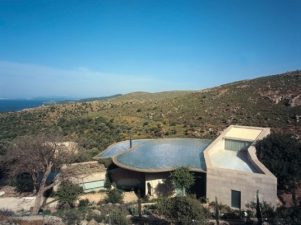 Image credit: © 2009 Farshid Assassi, Courtesy of BNIM Architects.
Image credit: © 2009 Farshid Assassi, Courtesy of BNIM Architects.
The International Living Building Institute Offers an Earthier, more Holistic Building Standard. The Omega Center for Sustainable Living (above) and the SF EcoCenter (below) are Potential Candidates for Certification.
Twenty-three years ago, when then Chair of the United Nation’s World Commission on Environment and Development first rejuvenated the term “sustainable development” in the Brundtland Report, surely she didn’t envision Dubai’s towering Burj Khalifa? By definition, buildings that are sustainable conserve an ecological balance by avoiding depletion of natural resources. Big Burj is looking decidedly unsustainable.
Something like Jerusalem’s living building, however, comes closer. Much closer, and demonstrates that despite the mainstream consumer mentality, people worldwide are deeply concerned about environmental degradation. News of inventive, ecologically based solutions flood the cyber waves. And each year, the Buckminster Fuller Challenge awards $100,000 to the best of them.
Bucky wasn’t full of himself
Buckminster Fuller was an untrained architect to whom the Geodesic Dome design is widely attributed (though Walther Bauersfeld created it 30 years before him.) The tally of Bucky’s accomplishments is too exhaustive to list, but his goal to operate with a “systemic worldview” endures. This put simply means to take the whole system into account: the birds, the land, the water, the people, the culture, and the unborn creatures and humans who have to live with our decisions. When creating cars or buildings, Buckminster Fuller wanted “to make the world work for 100% of humanity, in the shortest possible time, through spontaneous cooperation without ecological offense or disadvantage of anyone.”
Buildings like flowers?
Of the six finalists for this year’s competition, the Seattle, WA based International Living Building Institute ideology seemed to us most applicable to the Middle East. Their building standards stem from the same branch as other green building organizations such as the United States Green Building Institute, only they take their certification imperatives one step further. Theirs are only issued after 12 months of continuous operation for actual achievements, and are more holistic; they also represent the most advanced and current knowledge we have of balancing the built with the natural environment.
ILBI asks potential designers, politicians and citizens to imagine the following: “a building designed and constructed to function as elegantly and efficiently as a flower: a building informed by its bioregion’s characteristics, and that generates all of its own energy with renewable resources, captures and treats all of its water, and operates efficiently and for maximum beauty.” As resource-taxed as we in the Middle East often are, embracing this ideology could help stave off the worst and with any hope, restore existing environmental damage such as the dying Jordan River.
The petals
There are seven petals, which include: site, water, energy, health, materials, equity, and beauty, with subcategories outlining the 20 more detailed imperatives. Their standards can be applied to individual buildings or neighborhoods, to renovation projects, and even to infrastructure such as public bathrooms.
Essentially Living Buildings move away from centralized to decentralized systems. Instead of piping in energy and water from some distant place, or piping out waste mixed with precious potable water, every structure built according to these standards could be completely self-sustaining and beautiful. This is nature’s modus operandi: isn’t it about time that we incorporate the same?
The Living Green Challenge welcomes contact from Green Building Organization representatives interested in bringing Living Building Challenge to their country. For more information, click here.
Lead photo courtesy of the Omega Institute for Holistic Studies
:: Via Inhabitat
More on Green Building:
Tel Aviv’s Annual Architectural Weekend Celebrates Urban Green Spaces
Green Building in Iran: The “Bagdir” Windcatchers of Yadz
AIA Names Saudi’s KAUST In 2010 Top Green Projects


